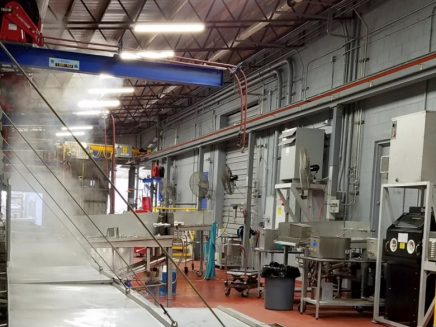PFC has over five decades of experience providing cleaning and passivating services to aerospace, semiconductor, food and beverage, fluid commodity industries, power generation, and trailer industries.
Passivation is the chemical treatment process applied to steel, and other metal to reduce the chemical reactivity of its surface. The primary aim behind the process is to enable the surface to resist corrosion.
The Concept of Passivation
Passivation makes use of mild oxidants like nitric and citric acid that effectively remove external contaminants like free iron, sulphides, and other foreign particles from the surface. This chemical treatment leads to the formation of an oxide layer, which acts as a protective shield. This oxide layer (or the "passive" layer) keeps the surface from chemically reacting with the air, preventing corrosion.
What is the Passivation Process?
First, the metal is cleaned with an alkaline solution to remove contaminants, oil, or grease. Then, it is rinsed with demineralized water, preferably using a jet nozzle. However, if required, a stiff bristle brush is also be used to remove foreign objects that might contaminate the oxide film.
Then, the stainless steel or metal is submerged in a chemical solution of citric acid or nitric acid for a specific duration and at a particular temperature. Chemical solution strength, temperature and contact time vary as per the chemical composition of the metal and the passivation specification.
When passivating stainless steel, the acid cleanses the surface of any free iron and leaves the surface with a higher proportion of chromium than the composition of the rest of the metal. As a result, when this surface is exposed to air, a thicker surface of chromium oxide is formed, rendering the metal non-reactive and making the metal resistant to rust.
While you can passivate stainless steel to improve its corrosion resistance, not all grades are suited for this process, and some parts may require additional cleaning operations beforehand.
Standards
Keeping in view the critical nature of the job and its massive impact on an organization's production operations, Passivation is heavily regularized, and the process has to follow standards set by different organizations like ASTM, ISO, ASME, SAE, FDA, and a few others.
Besides the standards, there are a few tests to confirm the removal of surface iron after Passivation, such as salt spray test and copper sulfate testing.
Preventions
While performing Passivation, it is necessary to stick to the industry standards and take care of two things. First, make sure that the citric or nitric acid being employed is contamination-free, of the proper solution strength and temperature.
The second thing to consider before immersing the metal in acid is the metal's composition. Make sure that metal of the same design and grade is being treated at one time.
Benefits:
It is well established that Passivation renders the metal surface to be contamination-free and prevents corrosion. However, there are a lot of added benefits to the process. For example:
- Quite obviously, it makes the metal surface look exceptional visually.
- Since rust weakens the structure, passivating the metal makes sure it maintains its strength.
- In components like transducers, slight rust can cause issues with electrical conduction. Passivation makes sure that the transducer fully retains its conduction capability.
- Slight rust in equipment can lead to massive faults, ultimately ruin production batches and also decrease the machine's life. Passivating the surface enhances the equipment's life and ensures smooth production.
Passivation Methods
There is more than one passivation technique, and these can be used alternatively for various machinery parts.
- Submersion – This is the method discussed above, where metal is submerged in a tank of acidic solution. This is the most common approach, and it applies to smaller equipment and parts which are easily dissembled.
- Circulation – This technique is used for pipes that usually carry corrosive liquids. An acidic solution is circulated through the entire piping system (along with valves and filters) to remove rust from the inside. Though these parts are not visible from the inside, their cleanliness is just as crucial as any external component.
- Spray Application – This method is used for the parts that cannot fit into the immersion tanks. Free iron and rust are removed through manual spraying of the acidic solution.
- Gel Application – This is also a manual method that is used to treat delicate areas or small welded spots that require detailed handwork.
These are a few techniques; however, choosing the suitable method depends on the client's requirement and the metal composition. As for complex issues, PFC is always available for guidance and application in a best-suited manner.
PFC performs passivating/passivation services to the following specifications:
| ASTM A380 | AMS-2700 | ASTM A967 |
| QQ-P-035 | RA1110-022 |

